Guest post written by: Mike Sheridan
One of the reasons I quit nutrition school is because class often consisted of discussing the benefits of foods that are clearly harmful, and learning tedious preparation methods for making them edible. After a considerable number of irritating debates with teachers and classmates (mostly vegetarians), it occurred to me that this probably wasn’t a designation I wanted to be associated with.
Call me a different cat, but the letters after my name have never meant much to me. Other than saving thousands of dollars on education, I can read the same textbooks, watch lectures from better educators, and form an opinion based on reliable evidence. With the current state of the medical profession, and the embarrassing recommendations from the government associations, I’d say my lack of fancy letters is a blessing in disguise…or at least that’s what I’m telling myself.
One of the best things about self-educating, is that you get to learn what you want, when you want. Whether this puts me at an advantage is debatable, but I’m sure as heck not wasting time learning the 58 side effects of a new pharmaceutical drug, or the American Diabetes Association’s (ADA) ridiculous nutrition recommendations for diabetics.
Why bother, when I know I can eat like a hunter-gatherer and never get sick?
And that the ADA’s recent dietary recommendations make a diabetics blood sugar look like this:
While a low-carb paleo plan makes it look like this: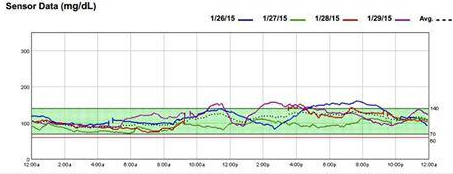
The other great thing about self-educating is thinking for yourself instead of being told how to think. Questioning the information instead of blindly following it.
Why sit through nutrition school learning the benefits of inedible grass seeds when I can question whether they’re worth consuming at all?
As you probably guessed from the title, I’m referring to grains. I know I’m preaching to the choir on this one, as most of you have already opted to avoid them entirely; however, there’s plenty of non-Paleo visitors to this website that are reluctant to change because of heavily inGRAINed beliefs. I’m hoping that the evidence and rationale I’ve put together below will put their apprehension to rest.
Who knows, maybe I can even get through to my old teachers and classmates!
Grains – The Promoted Pros
What are the benefits of eating grains? I don’t know, you tell me. My old classmates would probably tell you that they’re nutrient dense and packed with fiber. To which I ask:
“Compared to what?”
Grains are actually nutrient defunct compared to meat, nuts & seeds, and vegetables. At least when using Harvard Researcher, Matt Lalonde’s, Nutrient Density Value chart:
| Food Category | Nutrient Density Value |
| Organ Meat and Oils | 17 |
| Herbs and Spices | 17 |
| Nuts & Seeds | 10 |
| Cacao | 8 |
| Fish and Seafood | 1 |
| Pork | 0.7 |
| Beef | 0.3 |
| Eggs and Dairy | -0.6 |
| Vegetables (Raw) | -0.7 |
| Lamb, Veal, Raw Game | -1.2 |
| Poultry | -1.7 |
| Legumes | -2.9 |
| Processed Meat | -3.1 |
| Vegetables (Cooked, Canned) | -4.8 |
| Plant Fat and Oils | -5.4 |
| Fruits | -5.6 |
| Animal Skin and Feet | -6.2 |
| Grains (Cooked) | -6.2 |
| Refined and Processed Oils | -6.4 |
I’m not sure about you, but this chart leads me to believe that if I was concerned about nutrients, I should prioritize organ meat ands nuts and seeds. Likewise, it looks like a few pinches of cilantro, basil, and thyme, may be enough to make up for any lack of grains.
The dietician or nutritionist tells us we need whole grains for B-vitamins, but do we really?[i]
| Food | Mg per serving | |
| Thiamin (B1) | Sunflower Seeds (1/2 cup) | 1.08 |
| Ground Pork (75g) | 0.75 | |
| Oatmeal (1/2 cup) | 0.48 | |
| Riboflavin (B2) | Liver (75g) | 1.6-2.7 |
| Cuttlefish | 1.3 | |
| Eggs (2 large) | 0.5 | |
| Muesli cereal (1/2 cup) | 0.2 | |
| Niacin (B3) | Anchovies (75g) | 19.0 |
| Tuna (75g) | 12.0 | |
| Liver (75g) | 10.0 | |
| Chicken (75g) | 8.0 | |
| Mushrooms (1/2 cup) | 6.0 | |
| All Bran | 3.0 | |
| Pyridoxine (B6) | Liver (75g) | 0.76 |
| Tuna (75g) | 0.68 | |
| Venison (75g) | 0.57 | |
| Banana (1 medium) | 0.43 | |
| Wheat bran (1/2 cup) | 0.35 | |
| Folate (B9) | Liver (75g) | 420.0 |
| Lentils (1/2 cup) | 176.0 | |
| Okra (1/2 cup) | 142.0 | |
| Spinach (1/2 cup) | 121.0 | |
| FORTIFIED Pasta (1/2 cup) | 83.0 | |
| Whole Wheat Bread (1 slice) | 18.0 | |
| Cobalamin (B12) | Clams (75g) | 74.2 |
| Kidney (75g) | 59.2 | |
| Liver (75g) | 52.9 | |
| Oysters (75g) | 18.2 | |
| Mackeral (75g) | 13.5 | |
| Caribou (75g) | 5.0 | |
| All Grains | N/A (<0) |
Again, it appears animal source foods are superior. Especially when it comes to one of the most common deficiencies in B12.
In the year 2000, data from the Framingham Offspring Study found that nearly 40% of the adult population was flirting with B12 deficiency.[ii]
More importantly, the nutrient amounts listed for grains are nowhere near the same as what’s absorbed. In their ‘whole’ form, the vitamins and minerals are locked up in phytic acid;[iii] and in their refined form, the vitamins and minerals have been removed with the bran. In other words, even if you’re consuming the more nutrient dense source (whole grains), you’re not absorbing the nutrients.
Sadly, the phytic acid in grains also binds to essential minerals[iv] (like magnesium,[v] zinc,[vi] iron,[vii] and calcium[viii]) and reduces their absorption. Meaning, the grains themselves are not only inferior in nutrient content and availability, but they can disrupt the content and availability from other food sources. As the father of The Paleo Diet, Dr. Loren Cordain, lays out in The Paleo Answer:
Calcium absorbed with 100 calories of grain is 7.6 mg. Calcium absorbed in an equal amount of vegetables is 116.8 mg’s.
Arguably, this is why rickets and osteoporosis are extremely common in populations that rely heavily on cereal grains.[ix] And aside from a lack of animal protein, it’s also why vegetarians and vegans are commonly deficient in essential nutrients.[x]
So, should we eat whole grains for b-vitamins and nutrients?
Maybe if we’re about to die of starvation. Other than that, no! Clearly, the paleolithic foods have more nutrients, and unlike grains, they’re actually absorbed.
What About Fiber?
Conventional wisdom says the fiber in whole grains keeps us regular, and this prevents colon cancer, right?
It also lower cholesterol, and this prevents heart disease, right?
Sorry to burst your bubble, but you’re at risk of heart disease and colon cancer because you’re fat and inflamed. And the reason you’re fat and inflamed is because you listened to the government that told you to eat less meat and saturated fat and start stuffing your gullet with 6-11 servings of whole grains.
Meanwhile, there’s no association between fiber intake and colon cancer. This was concluded in a study from 1999 in the New England Journal of Medicine based on data from 89,000 Nurses:[xi]
“Our data do not support the existence of an important protective effect of dietary fiber against colorectal cancer or adenoma.”
And it’s the same story with heart disease. The only evidence producing a positive result attributed the lower risk to a “slight” decrease in total cholesterol;[xii] which is a horrible predictor of heart disease.[xiii]
More importantly, whole grains are extremely high in bodyfat-storing, insulin-raising, triglyceride-forming carbohydrates, and this increases our risk of heart disease far more than any indigestible fiber may lower it. In fact:
The DART study from 1989 looked at long-term fiber intake, and found that the group eating twice as much fiber ended up with a 23 percent greater risk of heart attack and a 27 percent increased risk of dying.[xiv]
Realistically, the ‘fiber’ in whole grains is the equivalent of swallowing a loufa – the body wash latherer that women (and some men) use in the shower.

Grains keep you regular because they’re predominantly insoluble fiber that you can’t digest. The only reason you think they’re beneficial is because they expand in water, push everything through your digestive system like a plunger, and make your deuces looks massive.
As you may’ve guessed, this does more harm than good when it comes to your health. Proper transit time and elimination speed is important, but when it’s too quick we run the risk of decreased absorption.[xv] And when that fiber source is grain, it causes inflammation,[xvi] and intestinal damage.[xvii] As researchers from the Medical College of Georgia put it:
““When you eat high-fiber foods, they bang up against the cells lining the gastrointestinal tract, rupturing their outer covering.”[xviii]
Basically, that loufa you’re eating is stiffer and pointier than the one in the pic.
Although the Cereal Giants will tell you otherwise, the health of your gastrointestinal system has less to do with transit time (mouth to butt speed), and more to do with the proportion of ‘good’ vs ‘bad’ bacteria in your colon, and integrity of your gut lining. Unlike grains, the soluble fiber in fruits and vegetables feeds healthy gut bacteria and facilitates the absorption of essential nutrients.[xix] The beneficial prebiotic content in these foods increases the production of short chain fatty acids (like butyric acid) and good bacteria (like bifidobacteria[xx]) in the colon, while improving nutrient absorption (like calcium and magnesium[xxi]) and reducing the key biomarkers (like fasting glucose) for diabetes and heart disease.
Interestingly, even if we forget about the inflammation, intestinal damage, and disrupted absorption with whole grains, fruits and vegetables supply more grams of fiber per serving:
- Half an avocado provides 6+ grams of fiber[xxii] – more than a bowl of oatmeal (4g)
- 1 cup of kale has more fiber than 3 slices of whole-wheat bread[xxiii]
- 1 artichoke supplies10+ grams of fiber[xxiv] – more than 3 bowls of Cheerios
As Dr. William Davis puts it:
“If you replace wheat calories with those from vegetables and raw nuts, fiber intake goes up.”
So, other than holding pizza toppings and adding handles to your hamburger, what’s the upside of eating grains?
And don’t tell me it’s fuel, as even the Institute of Medicine understands that:
“We don’t need carbohydrates for energy.”[xxv]
The reality is, there’s no upside – and plenty of downside.
Grains – The Consistent Cons
When foods are immunogenic it means they activate the immune system and induce inflammation. Although most make an effort to refrain from foods they’re allergic to (i.e. activates immunoglobulin E), many are unknowingly consuming foods that are immunogenic. The most common example is wheat, with some research showing that it promotes inflammation in more than 80% of the population.[xxvi]
Renowned gluten intolerance researcher, Dr. Kenneth Fine, believes 1 in 3 Americans are gluten intolerant and 8 in 10 has the genetic wiring to develop it.
Even if we forget about gluten, many of the gliadin proteins in wheat and other grains are responsible for inducing a pro-inflammatory immune response,[xxvii] whether the individual has a known intolerance or not. [xxviii] A paper from Ian Spreadbury in 2012 suggests that this is partly the result of an unfriendly bacteria left behind after the breakdown of acellular carbohydrates (grains, flour, sugar).[xxix]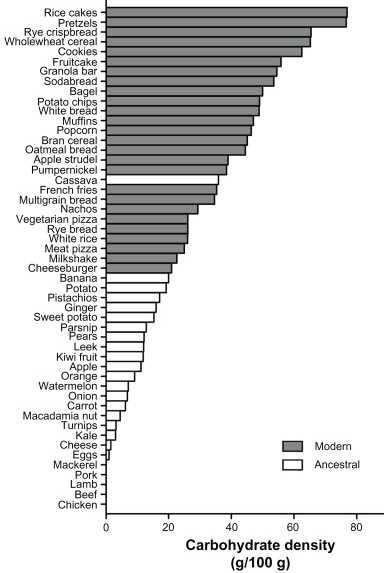
Basically, that loufa you just swallowed was a used one.
Similar findings have determined that an endotoxin called LPS (lipo-polysaccharides) is elevated in the GI tract when the typical High-Carbohydrate Grain-Dominant diet is consumed,[xxx] and this is strongly correlated with obesity and diabetes[xxxi] – something not seen in our grain-free paleolithic ancestors.[xxxii]
Chronic gut inflammation also promotes an increase in intestinal permeability (leaky gut), which is associated with various autoimmune[xxxiii] and inflammatory bowel disorders,[xxxiv] and negatively affects our absorption of essential vitamins and minerals.[xxxv] Essentially, grains are a double-whammy, as they damage the intestinal lining where nutrients are absorbed, and most of them come equipped with ‘anti-nutrients’ (phytic acid and lectins) that prevent nutrient availability.
A paper released in 2005 outlined that the switch to a cereal based (agrarian) diet high in anti-nutrients is to blame for the development of leptin resistance and the degenerative diseases that come with it.[xxxvi]
Although lectin activity has been demonstrated in a variety of grains (rye, barley, oats, etc), wheat-germ agglutinin (WGA) is the most heavily studied, and has it’s highest concentration in wheat.[xxxvii] WGA and other lectins have the ability to bind to nearly every cell type,[xxxviii] and notably those of the gut.[xxxix] Similar to gliadin and the other wheat proteins, lectins promote an inflammatory response[xl] and effect otherwise healthy individuals without a known allergy.[xli]
Yes, other foods are high in lectins and phytates (ex: nuts & seeds),[xlii] but there’s less reliance on these foods as a dietary staple. These ant-nutrients don’t seem to cause problems in small amounts,[xliii] but the digestive damage becomes increasingly prominent with consistent and excessive consumption. Sadly, this has become characteristic for the majority of the population when it comes to grains.
The cereal for breakfast, sandwich for lunch, pasta for dinner regimen damages the gut and leaves no opportunity for repair.[xliv]
The biggest concern is for those avoiding animal protein, as grains, beans, nuts, and seeds are their sole protein source. Not only does this leave them extremely deficient in essential nutrients because of a lack of meat, but the excessive intake of phytates and lectins decreases the availability in their foods, and damages the intestinal lining where nutrients are absorbed.[xlv]
A vegetarian will tell you that the phytates and lectins can be removed with proper preparation procedures (such as sprouting, soaking, drailing, and boiling), but research tells us that only 50% of phytates are removed with an 18hr soak,[xlvi] and most lectins are resistant to heat.[xlvii]
One study from 2002 in the Journal of Food Science determined that a16hr soak at 77 degrees Fahrenheit (or 3 day germination period) had no reduction in phytic acid.[xlviii]
More importantly, given the North American norm of prioritizing speed and convenience over quality, what percentage of the population is actually going to go through with this?
Is it just me or are we trying extremely hard to make a food edible and beneficial, that clearly isn’t edible and beneficial?
Maybe 0.0001% of the population will take the necessary 5 days to malt and sprout oats at 52 degrees Fahrenheit, and soak them for 17 hours at 120 degrees Fahrenheit to remove 98% of the phytic acid.[xlix] But after all that, what are we left with?
30 grams of carbohydrates in a ½ cup!
Regardless of whether or not you soak grains to remove the phytic acid and access more nutrients, it doesn’t change the fact that they’re still far too high in insulin-skyrocketing carbohydrates.[l] You know, the ones that continue to drive obesity through the ceiling.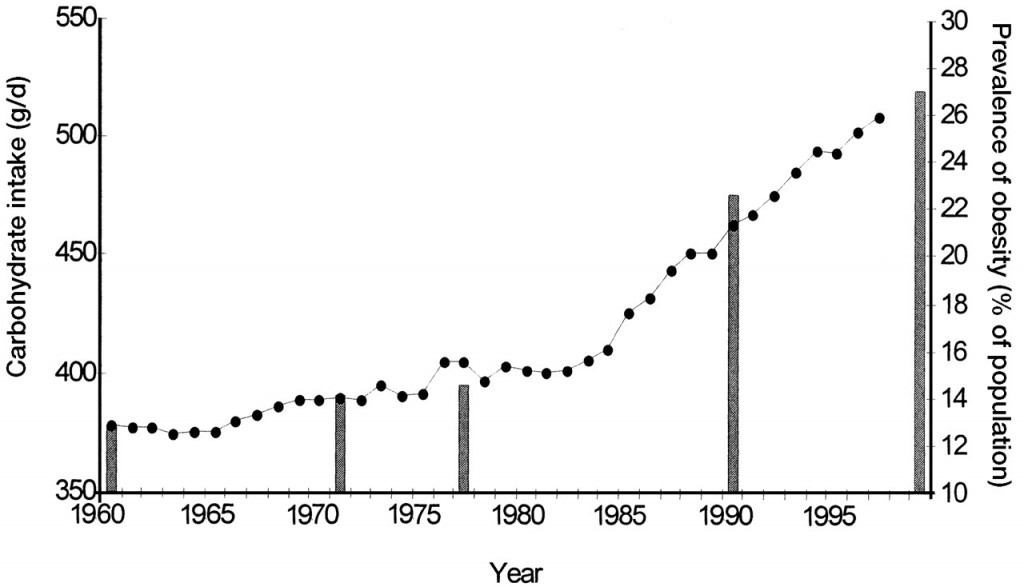
North Americans stay fat and get sick because they prioritize foods that are high in carbohydrates. And I’m not talking about the creamer in your coffee and candy in your top drawer. I mean the bagel for breakfast, pizza for lunch, pasta for dinner, and popcorn in front of the t.v.
Fortunately, many are finally receiving the message that sugar is bad, but they’re failing to recognize that the bread they’re putting zero-sugar jam raises their blood sugar faster than pure table sugar.[li]
What About Whole Grains?
Despite what you’ve been told (and continue to hear), the difference in blood sugar between whole and refined grains is negligible.[lii] Likewise, swapping refined grains for whole grains has no significant reductions in body fat or other risk factors for the metabolic syndrome.[liii]
But lets say we play along, and pretend that the fiber in whole grains really does make that much of a difference in blood sugar. This still doesn’t change the fact that we’re left with a food that excessively contributes to our daily carbohydrate load.
1 serving of grains is going to add at least 30 grams of nutrient degenerate carbohydrate, that is eventually broken down into the exact same simple sugars (glucose) as candy bars.[liv]
And aside from promoting insulin resistance, obesity, and diabetes, these chronically elevated blood sugar levels (hyperglycemia) are driving degenerative diseases of the heart[lv] and brain.[lvi] [lvii]
“Hyperglycemia (high blood sugar) has been proposed as a mechanism that may contribute to the association between diabetes and reduced cognitive function.”[lviii]
Sadly, the excess body fat[lix] and impaired glucose tolerance[lx] that develop from a diet dominated by high-glycemic carbohydrates are also directly associated with cancer mortality.[lxi]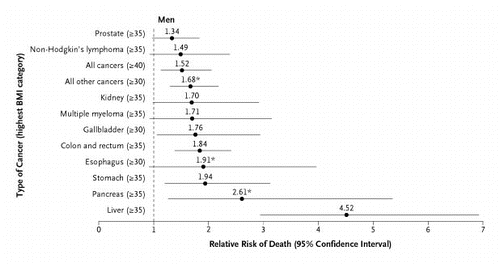
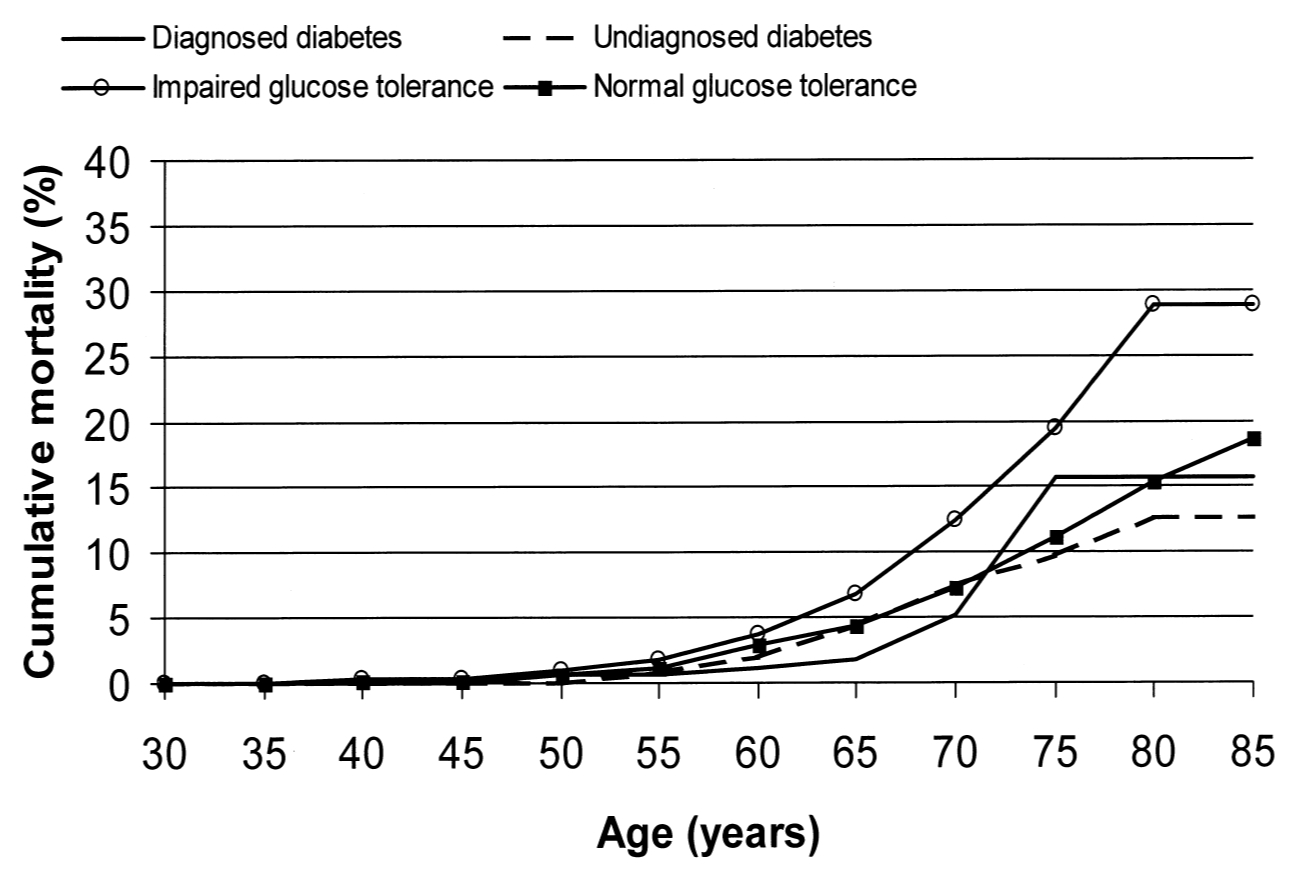
Grains – Lose/Lose
Basically, whole grains versus refined grains is a choice between inflammation and hyperglycemia, or unavailable and non-existent nutrients. Even if there was a blood sugar benefit (which there isn’t), it’s trumped by a loss in vitamin and minerals.
To say you eat grains for nutrients is like saying you go to the strip club for action. Although it appears they’re available, clearly you’re not getting any.
There’s plenty of foods that supply accessible nutrients and beneficial fiber, without the negative health consequences that come with grains. Bread and cereal companies and governments funded by them are going to tell you otherwise, but let’s remember what their livelihood depends on.
Grain Consumption = Bread & Cereal Sales = Government Funding
Sadly, your doctor will probably mislead you too; as aside from being to less nutrition classes than me,[lxii] he spends his time learning what they want. ‘They’ being the companies and governments that profit off you being sick.
Sick People = Pharmaceutical Sales = Government Funding
Personally, I wouldn’t trust anyone that says you need grains, because you don’t. What you need, is less body fat and inflammation, and a stronger, healthier gut.
Stay Lean!
Coach Mike
In Eat Meat And Stop Jogging, Mike Sheridan uncovers the flaws in the prevailing advice to get healthy and fit. Despite conventional beliefs, he contends that the instruction to limit red meat, restrict calories, increase fiber, run long distances, avoid saturated fat and reduce cholesterol is increasing our waistline, decreasing our lifespan, and leading to an unnecessary struggle.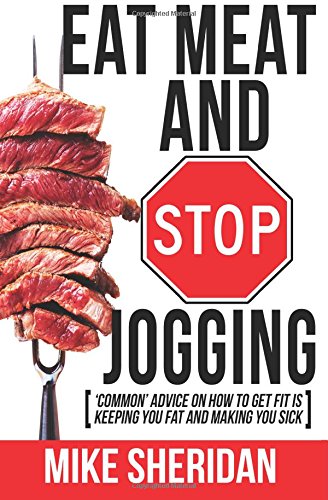
[i] http://www.dietitians.ca/Your-Health/Nutrition-A-Z/B-Vitamins.aspx
[ii] http://www.ars.usda.gov/is/pr/2000/000802.htm
[iii] http://ajcn.nutrition.org/content/38/6/835.full.pdf
[iv] http://jn.nutrition.org/content/129/7/1434S.full
[v] http://ajcn.nutrition.org/content/79/3/418.short
[vi] http://www.unboundmedicine.com/harrietlane/ub/citation/6496386/A_stable_isotope_study_of_zinc_absorption_in_young_men:_effects_of_phytate_and_alpha_cellulose_%20
[vii] http://www.ncbi.nlm.nih.gov/pubmed/3034044
[viii] http://www.ncbi.nlm.nih.gov/pubmed/3036926
[ix] http://www.thelancet.com/journals/lancet/article/PIIS0140-6736%2872%2990523-5/abstract
[x] http://ajcn.nutrition.org/content/45/4/785.short
[xi] http://www.ncbi.nlm.nih.gov/pubmed/9895396
[xii] http://www.ncbi.nlm.nih.gov/pubmed/9925120?dopt=Citation%20
[xiii] http://jama.jamanetwork.com/article.aspx?articleid=381733
[xiv] http://www.ncbi.nlm.nih.gov/pubmed/2547617
[xv] http://ajcn.nutrition.org/content/33/11/2397.full.pdf+html
[xvi] http://www.ncbi.nlm.nih.gov/pmc/articles/PMC3402009/
[xvii] http://www.mdpi.com/2072-6643/5/3/771/htm
[xviii] http://www.sciencedaily.com/releases/2006/08/060823093156.htm
[xix] http://jn.nutrition.org/content/133/1/1.full
[xx] http://jn.nutrition.org/content/129/7/1431S.full
[xxi] http://link.springer.com/article/10.1007%2Fs00394-004-0526-7
[xxii] http://jn.nutrition.org/content/132/7/2015.full
[xxiii] http://huhs.harvard.edu/assets/file/ourservices/service_nutrition_fiber.pdf
[xxiv] http://huhs.harvard.edu/assets/file/ourservices/service_nutrition_fiber.pdf
[xxv] http://www.huffingtonpost.ca/mike-sheridan/carbohydrates-and-energy_b_6823546.html
[xxvi] http://gut.bmj.com/content/56/6/889.extract
[xxvii] http://onlinelibrary.wiley.com/doi/10.1111/j.1365-2796.2011.02385.x/abstract;jsessionid=91D683B320900B055CD92C7504835E71.f03t01
[xxviii] http://onlinelibrary.wiley.com/doi/10.1111/j.1365-2567.2010.03378.x/abstract;jsessionid=7B2CE8DA05EDBCFDB852FFF9BE9930EC.f03t01
[xxix] http://www.ncbi.nlm.nih.gov/pmc/articles/PMC3402009/
[xxx] http://care.diabetesjournals.org/content/32/12/2281.full.pdf
[xxxi] http://care.diabetesjournals.org/content/34/8/1809.full.pdf
[xxxii] http://informahealthcare.com/doi/abs/10.1080/13590840310001619397
[xxxiii] http://link.springer.com/article/10.1007%2Fs12016-011-8291-x
[xxxiv] http://onlinelibrary.wiley.com/doi/10.1111/j.1365-2982.2010.01498.x/abstract;jsessionid=BBE9EB1718D6292F68F844D4F8A78C9B.f03t02
[xxxv] http://www.ncbi.nlm.nih.gov/pubmed/3034049
[xxxvi] http://www.biomedcentral.com/content/pdf/1472-6823-5-10.pdf
[xxxvii] http://www.sciencedirect.com/science/article/pii/0924224496100157
[xxxviii] http://journals.cambridge.org/action/displayAbstract?fromPage=online&aid=873700&fileId=S0007114593001254
[xxxix] http://link.springer.com/article/10.1007%2FBF00731295
[xl] http://onlinelibrary.wiley.com/doi/10.1002/%28SICI%291521-4141%28199903%2929:03%3C918::AID-IMMU918%3E3.0.CO;2-T/abstract;jsessionid=3676FA3FB1E8E318D29ADCB624E2EDB1.f03t02
[xli] http://www.sciencedirect.com/science/article/pii/S0014579396011544
[xlii] http://ajcn.nutrition.org/content/33/11/2338.full.pdf+html
[xliii] http://journals.cambridge.org/action/displayAbstract?fromPage=online&aid=873700&fileId=S0007114593001254
[xliv] http://journals.plos.org/plosone/article?id=10.1371/journal.pone.0000687
[xlv] http://www.ncbi.nlm.nih.gov/pmc/articles/PMC1115436/?tool=pubmed
[xlvi] http://www.sciencedirect.com/science/article/pii/0308814694902135
[xlvii] http://informahealthcare.com/doi/abs/10.3109/13590849109084100
[xlviii] http://onlinelibrary.wiley.com/doi/10.1111/j.1365-2621.2002.tb09609.x/abstract
[xlix] http://onlinelibrary.wiley.com/doi/10.1111/j.1365-2621.1992.tb14340.x/abstract
[l] http://m.ajcn.nutrition.org/content/76/1/5.full.pdf?sid=6f6fd7cc-dd9c-4c02-82b2-b959f5649453
[li] http://ajcn.nutrition.org/content/76/1/5.full
[lii] http://m.care.diabetesjournals.org/content/4/5/509.full.pdf
[liii] http://ajcn.nutrition.org/content/early/2014/06/18/ajcn.113.078048.short
[liv] http://www.huffingtonpost.ca/mike-sheridan/sugar-carbohydrates_b_6586584.html
[lv] http://care.diabetesjournals.org/content/early/2014/10/14/dc14-0360.abstract%20
[lvi] http://www.nejm.org/doi/full/10.1056/NEJMoa1215740
[lvii] http://www.neurology.org/content/79/10/1019
[lviii] http://www.ncbi.nlm.nih.gov/pubmed/22710333
[lix] http://www.nejm.org/doi/full/10.1056/NEJMoa021423
[lx] http://aje.oxfordjournals.org/content/157/12/1092.full.pdf
[lxi] http://www.ncbi.nlm.nih.gov/pmc/articles/PMC3267662/
[lxii] http://www.nature.com/ejcn/journal/v68/n7/abs/ejcn201475a.html

“Other than saving thousands of dollars on education, I can read the same textbooks, watch lectures from better educators, and form an opinion based on reliable evidence. With the current state of the medical profession, and the embarrassing recommendations from the government associations, I’d say my lack of fancy letters is a blessing in disguise…or at least that’s what I’m telling myself.”
I tell myself that too, but unfortunately, in today’s world, you need those stupid letters after your name if you ever hope to treat people directly for money. I use the Robb Wolf method, and that’s why I restrict my activities to myself and my family–nobody but Death himself can stop me there!
re: … unfortunately, in today’s world, you need those stupid letters after your name if you ever hope to treat people directly for money.
But unless those letters are the rank of MD or higher, in most places you’ll still be under the thumb of an MD, who may or may not genuflect to consensus deadly diet dogma.
If you just want to be a nutrition blogger, not having the letters is a time saver, because readers are dramatically less likely to ask for personal diagnoses and advice.
“To say you eat grains for nutrients is like saying you go to the strip club for action. Although it appears they’re available, clearly you’re not getting any.”
Best. Line. Ever.
Agreed, I was a big fan of that one myself haha.
I’ve damn near given up on even bothering to share nutritional articles on social media but that line swayed me to give this one a share!
Mr. Squatchy, my mother is suffering whith the Alzheimer’s disesase, and I’m wondering if you could indicate the source of the first and second graphs of your article. The ones which show the blood sugar levels at different types of diets. Thank you very much.
I would love to help, but the article was actually written by Mike Sheridan. I’m not sure where the graphs came from, hopefully he’ll chime in.
I thought Mat said that those nutrient densities weren’t as accurate as he’d like (I thought that was in one of Robb’s podcasts). Not sure if he ever updated them.
NIce to motivated
Mike –
What is the source for the two blood sugar charts at the beginning of the article? Fantastic pictures that illustrate how high carb diets flood your body with glucose. Then your pancreas releases massive doses of insulin reduce blood sugar to normal levels. While the Paleo diet maintains your blood sugar homeostasis.
Peter
I haven’t read the article yet, but plan to tonight. For some reason, I like to read comments often first. I am one of those non paleo “visitors”. I too have no official credentials. I read constantly and try my best to be as non bias as possible. I am a strict plant based eater. Very high carb, low fat, and low protein. The comment here is typical of what people think about high carb diets. A WFPB diet is high carb but it’s all GOOD carbs. They react in the body totally differently then bad carbs (mostly simple carbs) When you have all that fiber and good nutrients mixed in, there is no massive dose of insulin release, it’s slow and constant since there is no flooding of glucose. That’s why people have been cured, yes cured, over and over again from diabetes with plant based diets. Anyway, I’ll read the article tonight and try to respond.
Pretty convincing case for high protein diets … well done!
Great article, well researched, well cited!
My one complaint is the use of term “grains”, which is a very generic and blanket term that covers a number of different grains. I think this article would significantly better is it used the term “gluten containing grains”.
Avoiding all grains because of problem with some is like avoiding all fats because *some* of those fats are trans-fats, or like avoiding all proteins because some proteins might kill you (e.g. peanut proteins to a peanut allergic person).
There is plenty of science indicating that oats are, in fact, a beneficial grain (small sample here: http://superhumanradio.com/tags/oats.html). At the very least, Oat Beta-Glucan and avenanthramides (anti-oxidants unique to oats) appear to have numerous positive health benefits to them. Not to mention that oats have a significantly different macro profile than other grains, are relatively high in essential amino acids (for a plant food), are loaded with PUFAs, and significantly positive effects on the satiety hormones, specifically GLP1.
In short, oats are nutrient-rich food with none of the issues that come with gluten containing grains, have positive benefits unique to them (i.e. beta-glucan and avenanthramides), and have a well-balanced macro ratio.
So, just like we wouldn’t throw out the bacon fat with the trans-fats, let’s not toss the oats out with the gluten-containing grains!
Oats DO have a high degree of cross reactivity with gluten sensitive folks…not all clearly, but “a lot”. I am unfortunately one of those affected.
Robb,
Absolutely! I’m not saying that everyone will benefit from oats! Just like we don’t say everyone should avoid strawberries, just those allergic to them, I don’t think we should lump in all grains together. Sure, oats cross react with gluten, but so do a lot of things like coffee. Yet, we don’t advise people to avoid coffee unless they’re sensitive to that cross-reaction.
I’m also not advocating that everyone should consume oats either. Just trying to make the case that ‘grains are bad’ needs to be clarified. White rice is a grain, and most people admit it’s mostly benign and possibly may have some benefits. I think oats falls into that same category *if* you’re not sensitive to them.
I’m fortunate enough to not be gluten sensitive, and don’t cross-react with oats. So, if they work for me, there’s no real reason why I should avoid them. I’m guessing I’m not alone here, though possibly in a minority.
You’re not alone! I completely agree! Also, I’ve heard some about the benefits of buckwheat, but haven’t really taken the time to research it myself. But I do agree that we can’t lump all grains together in the same category. I consider myself an ‘ancestral’ eater but still eat white rice, oats, and buckwheat on occasion.
can I ask? what about Chickpea? is that a problem on a lowcarb high fat paleo diet? I eat no junk food, no sweet, no processesd food , only fruits and vegetables as carbs.
Good post. I think I recognise the CGM plots. 🙂
https://optimisingnutrition.wordpress.com/2015/03/22/diabetes-102/
Where you do Paleos stand on nuts and phytic acid? They clearly contain a lot and yet you recommend them in association with nutrient dense meals.
This is another question that concerns me, I would love to know the answer. Today I read that pumpkin seeds are high in phytic acid, so ditched them and not buying nuts anymore.
Having some phytic acid isn’t necessarily a bad thing, and it doesn’t need to be eliminated completely or anything.
I love the chart that compares B vitamins in whole grains to liver, other meat, chicken and seafood. It’s no coincidence that vegetarians and vegans have to take B complex vitamins to “supplement” their diet.
I am so, so tired of conflicting info. “Eat grains” “don’t eat grains” Internet is full of it. Of the more reliable sources such as this site I felt I was happy with ditching the grains, today came across Linda Carney’s website and it sounds like grains are the next best thing. Really I feel so frustrated, those people study and if they don’t know what is good and what is not, what can the likes of me make of it all! I am a mother to a small child and want to do the right thing for him, have no idea what the heck to feed him with!!!!
The moment I hear a “health professional” utter the words “healthy whole grains” I tune right out! Thanks for a really concise article!